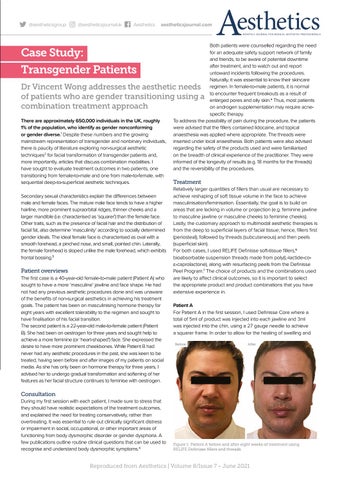@aestheticsgroup
@aestheticsjournaluk
Aesthetics
aestheticsjournal.com
Both patients were counselled regarding the need for an adequate safety support network of family and friends, to be aware of potential downtime after treatment, and to watch out and report untoward incidents following the procedures. Naturally, it was essential to know their skincare Dr Vincent Wong addresses the aesthetic needs regimen. In female-to-male patients, it is normal to encounter frequent breakouts as a result of of patients who are gender transitioning using a enlarged pores and oily skin.4 Thus, most patients on androgen supplementation may require acnecombination treatment approach specific therapy. There are approximately 650,000 individuals in the UK, roughly To address the possibility of pain during the procedure, the patients 1% of the population, who identify as gender nonconforming were advised that the fillers contained lidocaine, and topical or gender diverse.1 Despite these numbers and the growing anaesthesia was applied where appropriate. The threads were mainstream representation of transgender and nonbinary individuals, inserted under local anaesthesia. Both patients were also advised there is paucity of literature exploring non-surgical aesthetic regarding the safety of the products used and were familiarised techniques2 for facial transformation of transgender patients and, on the breadth of clinical experience of the practitioner. They were more importantly, articles that discuss combination modalities. I informed of the longevity of results (e.g. 18 months for the threads) have sought to evaluate treatment outcomes in two patients, one and the reversibility of the procedures. transitioning from female-to-male and one from male-to-female, with sequential deep-to-superficial aesthetic techniques. Treatment Relatively larger quantities of fillers than usual are necessary to Secondary sexual characteristics explain the differences between achieve reshaping of soft tissue volume in the face to achieve male and female faces. The mature male face tends to have a higher masculinisation/feminisation. Essentially, the goal is to build on hairline, more prominent supraorbital ridges, thinner cheeks and a areas that are lacking in volume or projection (e.g. feminine jawline larger mandible (i.e. characterised as ‘squarer’) than the female face. to masculine jawline or masculine cheeks to feminine cheeks). Other traits, such as the presence of facial hair and the distribution of Lastly, the customary approach to multimodal aesthetic therapies is facial fat, also determine ‘masculinity’ according to socially determined from the deep to superficial layers of facial tissue; hence, fillers first gender ideals. The ideal female face is characterised as oval with a (periosteal), followed by threads (subcutaneous) and then peels smooth forehead, a pinched nose, and small, pointed chin. Laterally, (superficial skin). the female forehead is sloped unlike the male forehead, which exhibits For both cases, I used RELIFE Definisse soft-tissue fillers,6 frontal bossing.3 bioabsorbable suspension threads made from poly(L-lactide-coε-caprolactone), along with resurfacing peels from the Definisse Patient overviews Peel Program.7 The choice of products and the combinations used The first case is a 40-year-old female-to-male patient (Patient A) who are likely to affect clinical outcomes, so it is important to select sought to have a more ‘masculine’ jawline and face shape. He had the appropriate product and product combinations that you have not had any previous aesthetic procedures done and was unaware extensive experience in. of the benefits of non-surgical aesthetics in achieving his treatment goals. The patient has been on masculinising hormone therapy for Patient A eight years with excellent tolerability to the regimen and sought to For Patient A in the first session, I used Definisse Core where a have finalisation of his facial transition. total of 5ml of product was injected into each jawline and 3ml The second patient is a 22-year-old male-to-female patient (Patient was injected into the chin, using a 27 gauge needle to achieve B). She had been on oestrogen for three years and sought help to a squarer frame. In order to allow for the healing of swelling and achieve a more feminine (or ‘heart-shaped’) face. She expressed the Before After desire to have more prominent cheekbones. While Patient B had never had any aesthetic procedures in the past, she was keen to be treated, having seen before and after images of my patients on social media. As she has only been on hormone therapy for three years, I advised her to undergo gradual transformation and softening of her features as her facial structure continues to feminise with oestrogen.
Case Study: Transgender Patients
Consultation During my first session with each patient, I made sure to stress that they should have realistic expectations of the treatment outcomes, and explained the need for treating conservatively, rather than overtreating. It was essential to rule out clinically significant distress or impairment in social, occupational, or other important areas of functioning from body dysmorphic disorder or gender dysphoria. A few publications outline routine clinical questions that can be used to recognise and understand body dysmorphic symptoms.4
Figure 1: Patient A before and after eight weeks of treatment using RELIFE Definisse fillers and threads
Reproduced from Aesthetics | Volume 8/Issue 7 - June 2021
















